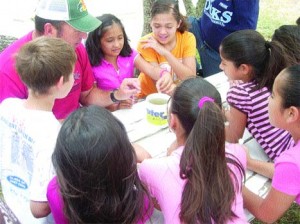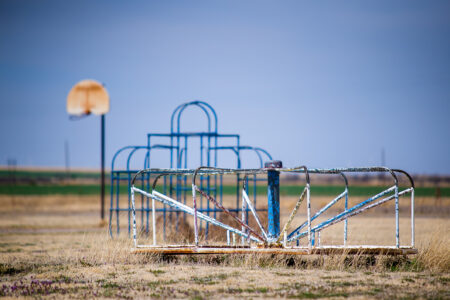Share On Social!
MHP (formerly known as Migrant Health Promotion) and Alice Independent School District partner to create a shared use agreement to make school-owned recreational areas—gyms, playgrounds, parks, and walking trails—available to the public after school hours, adding a much-needed physical activity option in a largely Latino population, at high risk of obesity and related health complications.
EMERGENCE
Awareness: Robert De Leon, a former program director at MHP—an organization that has provided leadership in health promotion, program development, and advocacy for migrant farmworkers and their families and other isolated communities since 1983—was increasingly concerned about high obesity rates in South Texas.
In 2011, MHP applied for a Texas Health Initiative’s Community Transformation Grant to focus new attention on promoting healthy lifestyles—through policy and program change—in Willacy and Jim Wells County, two-rural, border-area South Texas areas with largely Latino populations.
 View Willacy County health data here and Jim Wells County here.
View Willacy County health data here and Jim Wells County here.
After confirming the high rate of obesity in Jim Wells County (about 30% obese), De Leon and his program coordinator, Josephine Torres, decided to start their healthy lifestyles efforts in the county’s largest city, Alice, which has an 85% Latino population.
MHP put its initial focus on improving local access to spaces for physical activity.
De Leon and Torres soon became familiar with Dr. Grace Everett, superintendent of Alice Independent School District (Alice ISD). Everett, an Alice native and community activist who also had previously served as superintendent of the neighboring Palito-Blanco School District, was concerned about the larger-than-average rates of childhood obesity she saw in Alice and neighboring communities.
After receiving an American Diabetes Association grant, Palito-Blanco had implemented a health education program that added healthy snacks and different activities for the children in that district.
“Something similar to this would work very well in Alice, because we have the same problem here that we have in that community (Palito-Blanco),” Everett said. “It was interesting for me to try to get together with Mr. De Leon and try to pursue something down this avenue.”
In an initial conversation between Everett and MHP’s De Leon and Torres on how to increase access the physical activity options in Alice, Everett alerted MHP that Alice residents sometimes used walking paths on school property after hours, but that use was sporadic at best.
Despite this infrequent and informal use of walking trails, no formal agreement existed between the community and school district to ensure these facilities were available to Alice residents and to promote their use among residents.
Learn: Initial talks between Everett and MHP resulted in a decision: Work together to develop a shared-use agreement that would ensure that all Alice residents could confidently access walking paths behind district schools during after school hours.
De Leon and Torres began to research shared-use agreements on the Internet and found the ChangeLab Solutions Shared Use Agreement Toolkit and various YouTube videos to help them draft the agreement.
The Toolkit provides information on the following topics:
- research between poor health and limited access to recreational facilities;
- methods and techniques to foster support the state and local level;
- profiles of several shared use initiatives to illustrate how communities have negotiated and implemented agreements;
- an overview of the most common strategies for financing shared use agreements; and
- guidance on how to overcome difficulties in negotiating and enforcing a shared use agreement.
Frame Issue: De Leon recognized an opportunity to make a healthy change among community members who may or may not feel comfortable entering school grounds to walk on trails.
“We can’t assume that they know they can use the property after school hours,” De Leon said. “We can say that they may know, but do they really?”
So, after completing the ChangeLab Solutions steps, MHP and Everett drafted a proposed agreement between the school district (Alice ISD) and the community group (MHP)—a unique partnership because most shared use agreements are typically between a city and a school.
DEVELOPMENT
Education: De Leon explained that Alice residents could benefit greatly from a formal shared-use agreement because it would increase their access to district-owned facilities and provide residents with new, safe opportunities to improve their physical health.

Working with MHP to establish a shared-use agreement also would strengthen the community-school relationship in Alice, where the “community and schools are very much separated,” Everett said.
She believed that a partnership with MHP might would bridge this separation and spawn additional collaborations between Alice ISD and local groups.
“I truly believe the whole community has to raise these children,” Everett said.
Mobilization: Because some residents were already accessing the district’s walking paths, school board members initially did not believe a formal shared-use agreement was necessary, as some schools had informal open-door policies for their school walking paths.
Although the school board was initially uncertain about the benefits of the shared-use-agreement, Everett believed that all they needed was “convincing.”
“We really did want this partnership…our mission was to promote good health in this community as a whole,” Everett said.
De Leon agreed.
“[We want to] give you ideas to help improve the lives of the children you serve,” he told the board.
Debate: Around that time, the Alice ISD school board discovered that an Alice resident had bequeathed to the district the 300-acre Flournoy Park, which provides a walking path, pond, and picnic area.
School officials wondered: Why aren’t we utilizing that for something?
How can we involve other city groups in the revitalization of Flournoy Park?
Everett, in response, approached Community Action, a group that organizes community service as disciplinary action for adolescents. Community Action agreed to get involved in the cleanup of Flournoy Park for the local community.
In a logical extension of this effort, Everett and MHP decided to add Flournoy Park to their shared-use agreement, which heretofore had only included a provision for the walking trails.
Further debate and discussion led to adding more facilities to the agreement, including Alice ISD gyms, playgrounds, park, walking trails, and use of the football and soccer fields. They also decided that use of these facilities could be rented out for just $1 to any community group looking to host a health-related event on one of the school facilities.
ENACTMENT
Activation: MHP and Everett continued to inform the community about their plans to establish a shared-use agreement. Both Torres and Everett, who were members of different committees and groups, such as, the Jim Wells Economic Development Committee, Rotary Club and local churches, used those forums to garner local support for the agreement.
As discussions continued, more Alice residents and leaders began to understand what the benefits of such an agreement between MHP and Alice ISD could bring to the community.
A columnist with a local news organization, Alice24-7.com, applauded the move stating: “such measures can be cost effective in providing the community with a wider range of choices in pursuing their fitness and health goals and interests. It increases the benefits that the public receives from their tax investments, while at the same time, offering greater access to healthy lifestyle options that could possibly eventually include biking and skating possibilities.”
Frame policy: Having already drafted and framed the shared-use agreement, MHP also wanted to ensure there was a way to track the outcomes of such an agreement in Alice, a rural community.
Alice ISD agreed that such a measurement would help reveal the true benefits of a shared-use agreement, and the request was honored to add in observation measurements and survey outcomes.
Change: Alice ISD and MHP signed a five-year shared use agreement that is in effect through Nov. 26, 2017.
The groups announced the agreement to the public in January 2013.
The agreement officially allows the Alice community to use designated school district outdoor recreation facilities during non-school hours. The final agreement includes outdoor walking tracks, paths, Flournoy Park, and gyms on all Alice ISD campuses.
Additionally, during special and non-profit group events, the football fields and tracks will be available to the public for the rental fee of $1 per individual, along with a separate, additional fee of hiring a custodian and security guard for the event.
“The adoption of the shared use agreement model opens the door to behavioral changes in communities to help increase physical activity among children and adults, specifically those who live in rural communities or communities that lack recreational facilities,” De Leon told Alice24-7.com.
IMPLEMENTATION
Implementation: With the shared use agreement in place, these facilities now remain open to the public after school hours and on weekends. Though it was available informally before the shared use agreement had been established, community members can now access these facilities with no concerns of school grounds being unavailable.
Equity/Sustainability: As part of the agreement, MHP will develop a countywide needs assessment to capture important health information and assess the community’s awareness and use of these recreational facilities.
MHP is also developing a citywide media campaign to ensure residents know these facilities are open and available for their use.
“We found a study showing that increased physical activity can increase your lifespan up to five years,” said Josephine Torres.
This campaign, known as “Plus Five,” will target chronic obesity prevention and promote the benefits of physical activity. The target audience involves obesity prevention for children in addition to obesity management for adults.
“We found that the child obesity rate was increasing the chronic disease rate in children, and that the Plus Five initiative would allow them reach out to into the community and educate them on the benefits of increasing their physical activity…our goal is to link this to the City of Alice Fit and Family Fun Day,” said Torres.
The Family Fun Day, sponsored by the Jim Wells County Family Pride Council and Consumer Science Committee, will allow families to get together and engage in healthy, active lifestyles on a designated day each month.
Although effective for five years, school district leaders have voiced their ongoing support for the shared use agreement, and the MHP needs assessment is expected to fuel the agreement’s renewal or revision in 2017.
With the success of the shared use agreement, Alice ISD is optimistic of initiating new programs that aim to increase opportunities for the community to participate in health-promoting physical activity.
Everett has also generated participation from several other local organizations to continue the physical fitness campaign.
For example, the City of Alice will soon host various activities on school property, including local health fairs, a Fit and Family Fun Day, a Parent/Child Bike and Ride event, and visits from Power Team—a six-member group of former and current professional athletes visiting local schools in an effort to promote good health, welfare, and leadership among Alice children and adults—as part of a citywide outdoor initiative involving the Alice Area Alliance of Christian Churches (AAACC).
This success story was produced by Salud America! with support from the Robert Wood Johnson Foundation.
The stories are intended for educational and informative purposes. References to specific policymakers, individuals, schools, policies, or companies have been included solely to advance these purposes and do not constitute an endorsement, sponsorship, or recommendation. Stories are based on and told by real community members and are the opinions and views of the individuals whose stories are told. Organization and activities described were not supported by Salud America! or the Robert Wood Johnson Foundation and do not necessarily represent the views of Salud America! or the Robert Wood Johnson Foundation.
ABOUT THE PROGRAM
Salud America! The RWJF Research Network to Prevent Obesity Among Latino Children is a national program of the Robert Wood Johnson Foundation. The program aims to educate researchers, decision-makers, community leaders, and the public in contributing toward healthier Latino communities and seeking environmental and policy solutions to the epidemic of Latino childhood obesity. The network is directed by the Institute for Health Promotion Research at the University of Texas Health Science Center at San Antonio.
For more information, visit http://www.salud-america.org.
By The Numbers
33
percent
of Latinos live within walking distance (<1 mile) of a park
This success story was produced by Salud America! with support from the Robert Wood Johnson Foundation.
The stories are intended for educational and informative purposes. References to specific policymakers, individuals, schools, policies, or companies have been included solely to advance these purposes and do not constitute an endorsement, sponsorship, or recommendation. Stories are based on and told by real community members and are the opinions and views of the individuals whose stories are told. Organization and activities described were not supported by Salud America! or the Robert Wood Johnson Foundation and do not necessarily represent the views of Salud America! or the Robert Wood Johnson Foundation.



